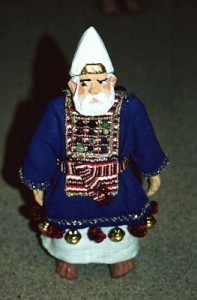Exodus 39:1, The holy garments for Aaron. The vestments of the high priest (kohen hagadol) are symbolic of the robes of righteousness that saints should be wearing in preparation for the return of the Messiah.
- Gold symbolizes purity of heart.
- Blue symbolizes heaven and spirituality. White linen pictures robes of righteousness.
- White symbolizes purity and sinlessness.
- Red represents blood—the blood of Yeshua that cleanses from sin.
- The high priest wore a belt that represents truth, according to Paul (Eph 6:14).
- White linen pants represented sexual purity.
- The white turban represented purity of thought and humility (the opposite of conceit).
- He wore a gold crown inscribed with the words, “Kadosh l’YHVH” meaning “Set-Apart to YHVH.”
- The dangling pomegranates represented the fruits of the Spirit of Elohim, which should be manifesting in the life of the saint. The golden bells jingled when the priest walked.
As we walk through life, people should hear and see our good spiritual fruits. All of our actions speak loudly and clearly as to who we are and what we believe. Also, Yeshua said that our words reveal the true condition of our heart (Luke 6:45). How do people really view us?
What are we really like when we are alone—our thought life and our words—our secret life? Is there a discrepancy between our secret and public lives? If so why? How set apart and righteous are we … in reality? If we are called to be a set-apart priesthood then hadn’t we better get busy cleaning up our act and start acting like one?
Jewish tradition tells us that a rope was tied to the leg of the high priest in Second Temple times so that while ministering in the innermost sanctuary of the temple if he was impure and YHVH struck him dead (as happened to Nadab and Abihu, the sons of Aaron, when they offered up strange fire) the corpse could be dragged out by the rope. Doesn’t all this show us that we should take being righteous and set apart seriously? Remember Hebrews 12:14: “Follow peace with all men, and holiness, without which no man will see the Master.”
As YHVH commanded Moses. In chapter 39, please observe the fact that all the work of the tabernacle was done “as YHVH commanded Moses” (or phrases similar to this), and these statements are repeated ten times in this chapter. YHVH gave specific instructions concerning the construction of the tabernacle and expected these instructions to be followed to the letter.
The tabernacle was the means by which the Israelites were to approach YHVH. Though the physical tabernacle is long gone, it still serves as a blueprint or pattern showing man the steps to reconciliation with his Creator. There is no other way to be reconciled to YHVH except through the steps of redemption outlined in the mishkan.
Furthermore, YHVH never gave any human the prerogative to add or subtract from his instructions. Discuss the implications of this with regards to our spiritual walk before our Heavenly Father. How important is it to follow all his instructions in righteousness? How often do we mitigate his instructions and reshape them to accommodate us? Isn’t this what the serpent persuaded Adam and Eve to do at the tree of knowledge, which is how sin entered the world?



Yeshua showed us that in his testimony, follow me and do as I do and all will be well with you. The Holy scriptures shows how we are to approach the King through our High priest Yeshua. Shalom my brother Natan